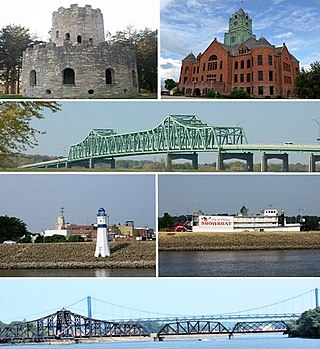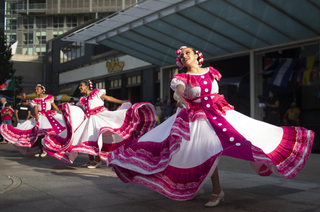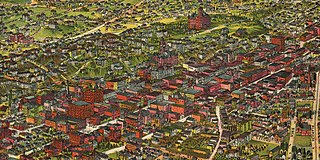

The Coldren Opera House was a theater that operated in Iowa City, Iowa, United States, from 1877 to 1912. Its site at 105 College Street, at the corner of Clinton Street, is now covered by the Ped Mall.


The Coldren Opera House was a theater that operated in Iowa City, Iowa, United States, from 1877 to 1912. Its site at 105 College Street, at the corner of Clinton Street, is now covered by the Ped Mall.
The Grand Opera House was built in 1876–77 to a design by Robert S. Finkbine. [1] It was dedicated on November 2, 1877 and opened on November 6 and 7 with performances of How Women Love and Van the Virginian. It occupied the second and third floors of the Iowa City Bank building, on the site of the Clinton House, an auditorium that had been destroyed by fire in 1872. [2] In addition to the bank, whose entrance was on the corner, the Opera House Bar was located in a first floor storefront on College Street. [3] It became known as the Coldren Opera House after John N. Coldren, who served as sheriff of Iowa City from 1877 to 1882, purchased it from the bank's owners, Ezekiel Clark and Thomas Hill. [2] [4]
The auditorium, measuring 50 by 60 feet, had a capacity of 1,050 on three levels (parquet, dress circle, and gallery), almost 1,400 with the addition of chairs in the aisles. [1] Following a fire, Coldren remodeled the interior in 1897 to seat 845. [5] Beethoven, Meyerbeer, Mozart, and Wagner were depicted in oils at the four corners of the auditorium, and Shakespeare above the proscenium arch. [1] The chandeliers and sconces and then state-of-the-art stage lighting gave the theater an excellent reputation. [2] [4]
The Opera House rarely if ever hosted opera performances; the name was used to avoid the less prestigious "theater". [5] In addition to plays, it was used for many civic functions, including inaugurations of University of Iowa presidents. On April 27, 1882, Oscar Wilde lectured there on "The Decorative Arts" during a speaking tour of the United States. [2] [6]
The Coldren Opera House closed in 1912 following the opening of the Englert Theatre, which seated 1,079. [7]

Leadville is a statutory city that is the county seat, the most populous community, and the only incorporated municipality in Lake County, Colorado, United States. The city population was 2,633 at the 2020 census. It is situated at an elevation of 10,158 feet (3,096 m). Leadville is the highest incorporated city in the United States and is surrounded by two of the tallest peaks in the state.

Louis Henry Sullivan was an American architect, and has been called a "father of skyscrapers" and "father of modernism." He was an influential architect of the Chicago School, a mentor to Frank Lloyd Wright, and an inspiration to the Chicago group of architects who have come to be known as the Prairie School. Along with Wright and Henry Hobson Richardson, Sullivan is one of "the recognized trinity of American architecture." The phrase "form follows function" is attributed to him, although the idea was theorised by Viollet le Duc who considered that structure and function in architecture should be the sole determinants of form. In 1944, Sullivan was the second architect to posthumously receive the AIA Gold Medal.

Johnson County is located in the U.S. state of Iowa. As of the 2020 census, the population was 152,854, making it the fourth-most populous county in Iowa. The county seat is Iowa City, home of the University of Iowa. Johnson County is included in the Iowa City metropolitan area, which is also included in the Cedar Rapids-Iowa City Corridor Combined Statistical Area.

Clinton is a city in and the county seat of Clinton County, Iowa, United States. It borders the Mississippi River. The population was 24,469 as of 2020.

Iowa City is the county seat and largest city of Johnson County, Iowa, United States. At the time of the 2020 census the population was 74,828, making it the state's fifth-most populous city. The Iowa City metropolitan area, which encompasses Johnson and Washington counties, has a population of over 171,000. The metro area is also a part of a combined statistical area with the Cedar Rapids metro area known as the Iowa City-Cedar Rapids region which collectively has a population of nearly 500,000.

The Auditorium Building in Chicago is one of the best-known designs of Louis Sullivan and Dankmar Adler. Completed in 1889, the building is located at the northwest corner of South Michigan Avenue and Ida B. Wells Drive. The building was designed to be a multi-use complex, including offices, a theater, and a hotel. As a young apprentice, Frank Lloyd Wright worked on some of the interior design.

Mount Vernon is a neighborhood of Baltimore, Maryland, located immediately north of the city's downtown. It is named for George Washington's Mount Vernon estate in Virginia, as the site of the city's Washington Monument.
Chickering & Sons was an American piano manufacturer located in Boston, Massachusetts. The company was founded in 1823 by Jonas Chickering and James Stewart, but the partnership dissolved four years later. By 1830 Jonas Chickering became partners with John Mackay, manufacturing pianos as "Chickering & Company", and later "Chickering & Mackays" until the senior Mackay's death in 1841, and reorganized as "Chickering & Sons" in 1853. Chickering pianos continued to be made until 1983.

The Academy of Music was a New York City opera house, located on the northeast corner of East 14th Street and Irving Place in Manhattan. The 4,000-seat hall opened on October 2, 1854. The review in The New York Times declared it to be an acoustical "triumph", but "In every other aspect ... a decided failure," complaining about the architecture, interior design and the closeness of the seating; although a follow-up several days later relented a bit, saying that the theater "looked more cheerful, and in every way more effective" than it had on opening night.
Denver Auditorium Arena was an indoor arena located at the corner of 13th and Champa Streets in Denver, Colorado. It was constructed as the Denver Municipal Auditorium in 1908 during the administration of Mayor Robert W. Speer. The building was opened on July 7, 1908, and was the site of the 1908 Democratic National Convention.

The Sioux City Municipal Auditorium, known as the Long Lines Family Recreation Center or Long Lines Auditorium for sponsorship reasons, is a multi-purpose facility in Sioux City, Iowa. The fifth in a line of major indoor venues built in Sioux City, it was designed by Knute E. Westerlind in 1938 and finally completed after many delays in 1950. In the building's original form, it was an arena that seated up to 3,500 people. In 2003, the building was replaced by the Tyson Events Center, built around the northeast corner of the Municipal Auditorium. The building was then converted to its current use as a recreation center while preserving the exterior building. The converted arena was originally named Long Lines Family Recreation Center, though in 2023 the building added the Long Lines Auditorium signing to the southeast entrance and inside the auditorium. The auditorium is referred to as either name.

The Ped Mall, also known as the Pedestrian Mall, is a pedestrian mall located in downtown Iowa City, Iowa, near the University of Iowa campus. Officially named City Plaza it was completed in 1979 as the centerpiece of the city's urban renewal project. Landscaping was completed the following year. It was designed by Jack Leaman of Associated Engineers, Inc., in Mason City, Iowa. While pedestrian malls were a common feature of urban renewal projects in the United States, the Iowa City Ped Mall is one of the few that is still in existence. Spanning from Burlington Street to Washington Street and Clinton Street to Linn Street, the Ped Mall serves as a gathering place for students, locals, and transients. It draws large crowds for its summertime events such as the Friday Night Concert Series and the annual Iowa City Jazz Festival and Iowa City Arts Festival. The Ped Mall area also contains restaurants, bars, retail, hotels, a playground for children, and the Iowa City Public Library. The Coldren Opera House was located on the street which has now become the mall. In 2021, it was included as a contributing property in the Iowa City Downtown Historic District.

The St. Louis Mercantile Library, founded in 1846 in downtown St. Louis, Missouri, was originally established as a membership library, and is the oldest extant library west of the Mississippi River. Since 1998 the library has been housed at the University of Missouri-St. Louis as a Special Collections library within the Thomas Jefferson Library. The majority of library materials can be assigned to one of four categories: the General (Core) Collection, the John W. Barriger Railroad Library, the Herman T. Pott National Inland Waterways Library, or the Art Museum. The collections of the St. Louis Mercantile Library have been named a City Landmark by the city of St. Louis, Mo., due to the cultural significance of the library.

The Old National Centre, formerly known as the Murat Shrine Temple and the Murat Shrine Center, is located at North and New Jersey streets in Indianapolis, Indiana, and is owned by the Murat Shriners of the Ancient Arabic Order of the Nobles of the Mystic Shrine. The theater portion of the building is now known as the Murat Theatre at Old National Centre or simply the Murat Theatre and houses the oldest extant stage house in downtown Indianapolis. It is the only Shrine Center in the world with a name of French origin and is the largest Shrine Center in North America.

The Grand Opera House was an opera house and concert hall located in Toronto, Ontario, Canada.
Main Street is a major north–south thoroughfare in Los Angeles, California. It serves as the east–west postal divider for the city and the county as well.

Englert Theatre in Iowa City, Iowa, is a renovated vaudeville-era playhouse now serving as a community arts center and 725-seat performance venue. It is owned and operated year around by Englert Civic Theatre, a non-profit art organization. The building was individually listed on the National Register of Historic Places in 2001. In 2021, it was included as a contributing property in the Iowa City Downtown Historic District.

The Wheeler Opera House is located at the corner of East Hyman Avenue and South Mill Street in Aspen, Colorado, United States. It is a stone building erected during the 1890s, from a design by Willoughby J. Edbrooke that blends elements of the Romanesque Revival and Italianate architectural styles. In 1972 it became the first property in the city to be listed on the National Register of Historic Places, and the second in Pitkin County. The upstairs auditorium hosts a number of events every year, ranging from nationally prominent music and comedy acts and some of the Aspen Music Festival's events to productions by local community groups.

The Globe Theatre (est.1871) was a playhouse in Boston, Massachusetts, in the 19th century. It was located at 598 Washington Street, near the corner of Essex Street. Arthur Cheney oversaw the Globe until 1876. From 1871 to 1873 it occupied the former theatre of John H. Selwyn. After a fire in May 1873, the Globe re-opened on the same site in December 1874. Architect Benjamin F. Dwight designed the new building. From 1877 to 1893 John Stetson served as proprietor; some regarded him as "a theatrical producer with a reputation for illiteracy in his day such as Samuel Goldwyn has achieved" in the 1960s. The theatre burned down in January 1894.

The late-Victorian-era Downtown of Los Angeles in 1880 was centered at the southern end of the Los Angeles Plaza area, and over the next two decades, it extended south and west along Main Street, Spring Street, and Broadway towards Third Street. Most of the 19th-century buildings no longer exist, surviving only in the Plaza area or south of Second Street. The rest were demolished to make way for the Civic Center district with City Hall, numerous courthouses, and other municipal, county, state and federal buildings, and Times Mirror Square. This article covers that area, between the Plaza, 3rd St., Los Angeles St., and Broadway, during the period 1880 through the period of demolition (1920s–1950s).